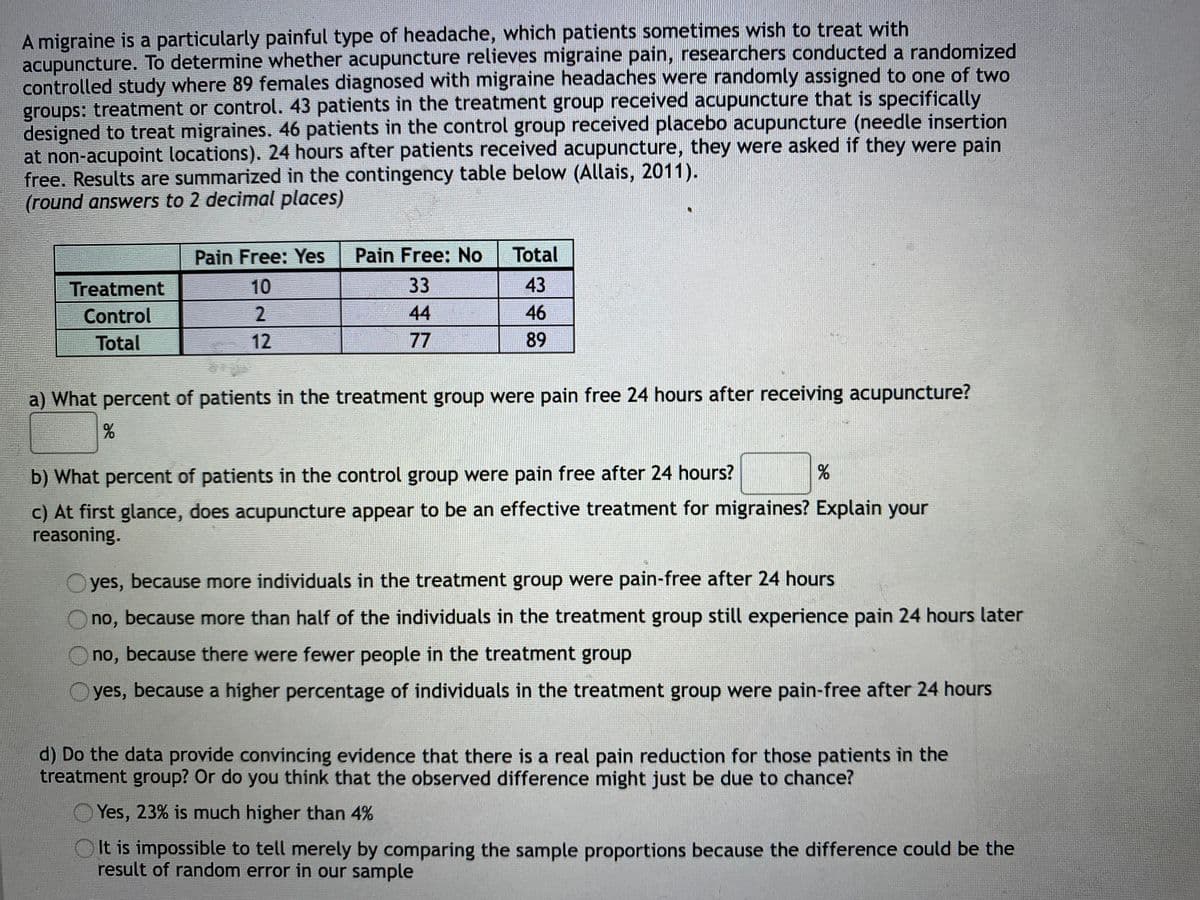A migraine is a particularly painful type of headache, which patients sometimes wish to treat with acupuncture. To determine whether acupuncture relieves migraine pain, researchers conducted a randomized controlled study where 89 females diagnosed with migraine headaches were randomly assigned to one of two groups: treatment or control. 43 patients in the treatment group received acupuncture that is specifically designed to treat migraines. 46 patients in the control group received placebo acupuncture (needle insertion at non-acupoint locations). 24 hours after patients received acupuncture, they were asked if they were pain free. Results are summarized in the contingency table below (Allais, 2011). (round answers to 2 decimal places) Pain Free: Yes Pain Free: No Total
A migraine is a particularly painful type of headache, which patients sometimes wish to treat with acupuncture. To determine whether acupuncture relieves migraine pain, researchers conducted a randomized controlled study where 89 females diagnosed with migraine headaches were randomly assigned to one of two groups: treatment or control. 43 patients in the treatment group received acupuncture that is specifically designed to treat migraines. 46 patients in the control group received placebo acupuncture (needle insertion at non-acupoint locations). 24 hours after patients received acupuncture, they were asked if they were pain free. Results are summarized in the contingency table below (Allais, 2011). (round answers to 2 decimal places) Pain Free: Yes Pain Free: No Total
Holt Mcdougal Larson Pre-algebra: Student Edition 2012
1st Edition
ISBN:9780547587776
Author:HOLT MCDOUGAL
Publisher:HOLT MCDOUGAL
Chapter11: Data Analysis And Probability
Section: Chapter Questions
Problem 8CR
Related questions
Topic Video
Question

Transcribed Image Text:A migraine is a particularly painful type of headache, which patients sometimes wish to treat with
acupuncture. To determine whether acupuncture relieves migraine pain, researchers conducted a randomized
controlled study where 89 females diagnosed with migraine headaches were randomly assigned to one of two
groups: treatment or control. 43 patients in the treatment group received acupuncture that is specifically
designed to treat migraines. 46 patients in the control group received placebo acupuncture (needle insertion
at non-acupoint locations). 24 hours after patients received acupuncture, they were asked if they were pain
free. Results are summarized in the contingency table below (Allais, 2011).
(round answers to 2 decimal places)
Pain Free: Yes
Pain Free: No
Total
Treatment
10
33
43
Control
44
46
Total
12
77
89
a) What percent of patients in the treatment group were pain free 24 hours after receiving acupuncture?
b) What percent of patients in the control group were pain free after 24 hours?
c) At first glance, does acupuncture appear to be an effective treatment for migraines? Explain your
reasoning.
O yes, because more individuals in the treatment group were pain-free after 24 hours
no, because more than half of the individuals in the treatment group still experience pain 24 hours later
no, because there were fewer people in the treatment group
O yes, because a higher percentage of individuals in the treatment group were pain-free after 24 hours
d) Do the data provide convincing evidence that there is a real pain reduction for those patients in the
treatment group? Or do you think that the observed difference might just be due to chance?
Yes, 23% is much higher than 4%
OIt is impossible to tell merely by comparing the sample proportions because the difference could be the
result of random error in our sample
Expert Solution
This question has been solved!
Explore an expertly crafted, step-by-step solution for a thorough understanding of key concepts.
This is a popular solution!
Trending now
This is a popular solution!
Step by step
Solved in 2 steps

Knowledge Booster
Learn more about
Need a deep-dive on the concept behind this application? Look no further. Learn more about this topic, statistics and related others by exploring similar questions and additional content below.Recommended textbooks for you

Holt Mcdougal Larson Pre-algebra: Student Edition…
Algebra
ISBN:
9780547587776
Author:
HOLT MCDOUGAL
Publisher:
HOLT MCDOUGAL

College Algebra (MindTap Course List)
Algebra
ISBN:
9781305652231
Author:
R. David Gustafson, Jeff Hughes
Publisher:
Cengage Learning

Holt Mcdougal Larson Pre-algebra: Student Edition…
Algebra
ISBN:
9780547587776
Author:
HOLT MCDOUGAL
Publisher:
HOLT MCDOUGAL

College Algebra (MindTap Course List)
Algebra
ISBN:
9781305652231
Author:
R. David Gustafson, Jeff Hughes
Publisher:
Cengage Learning